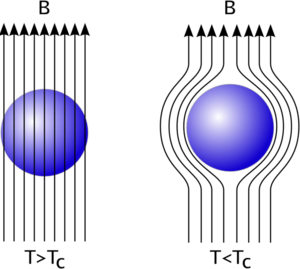Superconductor

A superconductor is a material that has absolutely no electrical resistance (0 Ω) and interesting interactions with magnetic fields. Because of this, it can transmit electricity without producing any waste heat. This material must be cooled below the critical temperature, which is usually very cold. For most materials the critical temperature is a few Kelvin (a few degrees above absolute zero). Some materials have a critical temperature as high as 125K or so (-148°C, much colder than even cold parts of Canada!). While these materials may have uses in energy storage (see for example superconducting magnetic energy storage), it's unlikely that they will be used for transmitting electricity over long distances on the electrical grid anytime soon, due to the difficulty of cooling thousands of kilometers of transmission lines.
Oddly, superconductors above their critical temperatures are often not even conductors.
Figure 2 shows the difference between how much cable is required for 12,500 amperes (an enormous amount of current). As shown in the figure, superconductors are capable of carrying quite a bit more current than normal conductors.

For Further Reading
For more information on this fascinating subject please see hyperphysics, specifically the articles on high temperature superconductors.
- Resistivity
- Electrical conductivity
- Electric current
- Or explore a random page!
References
- ↑ Piotr Jaworski, PioM EN DE PL; POLAND/Poznań / Public domain from https://commons.wikimedia.org/wiki/File:EfektMeisnera.svg accessed February 25th, 2020.
- ↑ By Rama - Own work, CC BY-SA 2.0 fr, https://commons.wikimedia.org/w/index.php?curid=601147 accessed May 9th, 2018.

